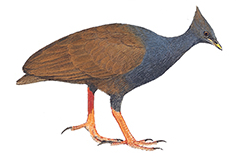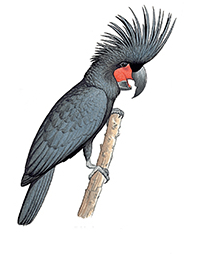
Birds of a feather: Is bird watching the next hipster activity?
Bird watching is a hobby that’s really been taking flight lately. It’s no longer just for camouflage-wearing seniors (not that there’s anything wrong with that). It’s a growing trend attracting a nature-loving younger generation too as they try to snap a great pic for Instagram getting on the bird bandwagon too.
And a great bonus is that our citizen science data on different species has helpfully been increasing too.
Technology advances in camera quality and web-based image sharing and storing has paved the way for an unprecedented amount of data to be available about virtually all of Australia’s diverse bird species. A quick look at our Atlas of Living Australia and you can see just how much citizen scientists is helping researchers cover more ground than ever possible below.
Naturally, with all this new information to hand, we jumped at the opportunity to produce a more detailed Australian bird field guide to meet the needs of the new breed of bird watcher.
Earlier this year CSIRO Publishing released the most comprehensive Australian bird guide ever published – The Australian Bird Guide, created by a dream team of authors and artists.
And while there is nearly 550 pages of beautifully hand drawn bird species in the book that could be pored over this National Bird Week, we also thought we’d help out with some bird-watching tips for those looking to up their insta-game ‘in the field’.
Together with the authors we’ve compiled a state-by-state list of common and hard-to-find species where you live.

Even novice bird watchers should be able to spy the Orange-footed Scrubfowl outside the NT Parliament building in Darwin.
New to bird-watching – common birds to find in your state and territory
Some species are common over much of the continent – Australian Magpie, Magpie-lark, Willie Wagtail, Galah, Welcome Swallow and the White-faced Heron, for example.
ACT: Gang-gang Cockatoo, Crimson Rosella, Superb Fairy-wren, Pied Currawong, Red Wattlebird
NSW: Eastern Koel, Australian Raven, Emu, Noisy Miner, Rainbow Lorikeet, Australian White Ibis
NT: Orange-footed Scrubfowl (outside the NT Parliament building in Darwin), Magpie Goose, Pied Heron, Rainbow Bee-eater, Black Kite
QLD: Pied Imperial-Pigeon, Pied Butchbird, Red-tailed Black-Cockatoo, Australian Brush-turkey, Olive-backed Sunbird
SA: Crested Pigeon, Adelaide Rosella, Galah, Australian Ringneck, Wedge-tailed Eagle
TAS: Yellow Wattlebird, Kelp Gull, Yellow-throated Honeyeater, Tasmanian Native-hen, Masked Lapwing.
VIC: Grey Fantail, Pacific Gull, Superb Lyrebird, Sulphur-crested Cockatoo, Little Penguin, Golden Whistler
WA: Singing Honeyeater, Black-faced Woodswallow, Willie Wagtail, Eastern Osprey, Zebra Finch

The Palm Cockatoo can be spotted by keen bird watchers in Queensland
For advanced birdwatchers – the rare or most sought after birds to find in your state and territory
ACT: Spotted Quail-thrush, Superb Parrot, Chestnut-rumped Heathwren
NSW: Rufous Scrub-bird – can be heard at the right locations but very hard to see and very rarely photographed; Rock Warbler – endemic to the Sydney Sandstone country and Blue Mountains; Plains-wanderer, Freckled Duck; Bar-tailed Godwit
NT: Red Goshawk – fierce aerial predator, in iconic places like Kakadu; Gouldian Finch, Chestnut Rail, Banded Fruit-Dove
QLD: Night Parrot – really can’t overlook this one. We provide the first field guide account that captures new information from the rediscovery of the species in 2013, and we illustrate a juvenile for the first time.
Palm Cockatoo, Eungella Honeyeater, Lesser Sooty Owl, Golden Bowerbird
SA: Nullarbor Quail-thrush, Black-eared Miner, Chestnut-breasted Whiteface, Western Whipbird, Red-lored Whistler
TAS: Orange-bellied Parrot, Australian Masked Owl, Ground Parrot, Beautiful Firetail, Southern Royal Albatross
VIC: Mallee Emu-wren (now a state endemic), Australasian Bittern, Malleefowl, Rufous Bristlebird
WA: Black Grasswren – restricted to the nw Kimberley – amongst the most special of a very special group.
Princess Parrot – restricted to sandplain deserts that are difficult to access, e.g. Canning Stock Route, very beautiful pastel colours and elegant shape, occasionally irrupts into more accessible country such as west of Alice Springs


3rd September 2019 at 9:38 pm
I agree Ian, I was getting quite interested until I read that seniors line…
5th December 2018 at 10:54 pm
Has anyone noticed an adverse relationship between Scrub Turkey’s and Australian Ravens? Until recently we had 5 Scrub Turkey’s regular ly visiting but since 3 Australian Ravens took up residence we didn’t see any for a while and now just the occasional lone male.
27th October 2017 at 11:41 am
@Ian Taylor Just a bundle of positivity aren’t ya Ian. I personally thought this was a very informative article. I’d love to see more people (especially the younger generations) caring for our avian friends out there. It’d be a very welcome change.
23rd October 2017 at 11:22 am
C’mon folks, you’re the CSIRO, set an example and get your English right! It’s ‘pored over’, not ‘poured over.’ You can drop the ageism too – “It’s no longer just for camouflage-wearing seniors (not that there’s anything wrong with that).”